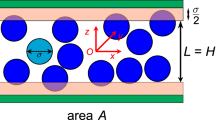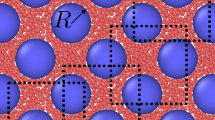Abstract
Closed equations of fluid transfer in confined conditions are constructed in this study using ab initio methods of nonequilibrium statistical mechanics. It is shown that the fluid viscosity is not determined by the fluid properties alone, but becomes a property of the “fluid-nanochannel walls” system as a whole. Relations for the tensor of stresses and the interphase force, which specifies the exchange by momentum of fluid molecules with the channel-wall molecules, are derived. It is shown that the coefficient of viscosity is now determined by the sum of three contributions. The first contribution coincides with the expression for the coefficient of the viscosity of fluid in the bulk being specified by the interaction of fluid molecules with each other. The second contribution has the same structure as the first one but is determined by the interaction of fluid molecules with the channel-wall molecules. Finally, the third contribution has no analog in the usual statistical mechanics of transport processes of a simple fluid. It is associated with the correlation of intermolecular forces of the fluid and the channel walls. Thus, it is established that the coefficient of viscosity of fluid in sufficiently small channels will substantially differ from its bulk value.
Similar content being viewed by others
References
V. A. Andryushchenko and V. Ya. Rudyak, Dokl. Akad. Nauk Vyssh. Shkoly Ross. Fed., No. 2 (15), 6 (2010).
V. Andryuschenko and V. Rudyak, Defect Diffus. Forum 312–315, 417 (2011).
V. Ya. Rudyak, A. A. Belkin, V. V. Egorov, and D. A. Ivanov, Int. J. Multiphys. 5(2), 145 (2011).
V. A. Andryushchenko and V. Ya. Rudyak, Vestn. Tomsk Gos. Univ. Ser. Mat. Mekh. 18(2), 63 (2012).
G. Karnidakis, A. Beskok, and N. Aluru, Microflows and Nanoflows. Interdiscipl. Appl. Math. (Springer, Berlin, 2005).
V. Ya. Rudyak, Statistic Aerohydromechanics of Homogeneous and Heterogeneous Media, vol. 2: Hydrodynamics (Novosibirsk State Univ. Architect. Build. (NGASU), Novosibirsk, 2005) [in Russian].
V. Ya. Rudyak and A. A. Belkin, Mat. Model. 8(6), 33 (1996).
V. Ya. Rudyak and A. A. Belkin, Sib. Zh. Industr. Mat., No. 1 (9), 145 (2002).
V. Ya. Rudyak and A. A. Belkin, J. Aerosol Sci. 25(Suppl. 1), S421 (1994).
D. N. Zubarev, Nonequilibrium Statistical Thermodynamics (Nauka, Moscow, 1971).
Author information
Authors and Affiliations
Corresponding author
Additional information
Original Russian Text © V.Ya. Rudyak, A.A. Belkin, 2014, published in Doklady Akademii Nauk, 2014, Vol. 459, No. 6, pp. 696–698.
Rights and permissions
About this article
Cite this article
Rudyak, V.Y., Belkin, A.A. Fluid viscosity under confined conditions. Dokl. Phys. 59, 604–606 (2014). https://doi.org/10.1134/S1028335814110044
Received:
Published:
Issue Date:
DOI: https://doi.org/10.1134/S1028335814110044




